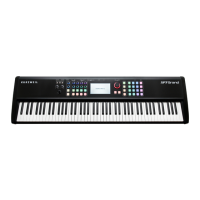20
Chapter 3. Sound Editing
Chapter 3
3-2-3-4 AUX EQ
The Aux EQ tab offers adjustments covering the 4 frequency bands of the Aux EQ:
EQ Low Gain : This function adjusts the low frequency range.
EQ Mid Low Gain : This function adjusts the low-mid frequency range.
EQ Mid High Gain : This function adjusts the high-mid frequency range.
EQ High Gain : This function adjusts the high frequency range.
3-2-3-5 Zone IFX (Zone Insert Effect)
The “Zone IFX” tab offers 4 possible destinations governing the IFX Mixer:
Output Volume : This function controls the volume level of the post IFX/pre Aux FX signal.
Pan : This function adjusts the left/right balance of the post IFX/pre Aux FX signal.
Reverb Send : This function controls the amount of post IFX sent to the Aux Reverb.
ChoDly Send : This function controls the amount of post IFX signal sent to the Aux Chorus and Delay.
3-2-3-6 Audio FX
The “Audio FX” tab offers 4 possible destinations governing the Audio Input Mixer:
Output Volume : This function controls the volume level of the post IFX/pre Aux FX signal.
Pan : This function adjusts the left/right balance of the post IFX/pre Aux FX signal.
Reverb Send : This function controls the amount of post IFX sent to the Aux Reverb.
ChoDly Send : This function controls the amount of post IFX signal sent to the Aux Chorus and Delay.
3-2-3-7 Vocal Proc
The Vocal Processor tab offers 3 possible destinations governing the Vocal Processor section:
Lead Process On/Off : This function turns the Lead Processing section on/off.
Auto Harm On/Off : This function turns the Auto Harmony section on/off.
Auto Harm Volume : This function controls the volume level of the Auto Harmony section.
3-2-3-8 Notes
The Notes tab allows you to select individual MIDI note numbers (#0-127) to trigger from the selected controller
button. The note velocity is determined by the Max Value. This function can be usefully for triggering percussion
hits and sound effects.

